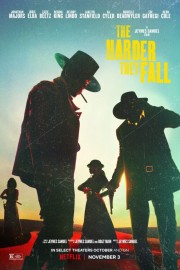The Harder They Fall
I think I like the version of historical fiction brought to the screen by Jeymes Samuel in “The Harder They Fall” a lot more than I do Quentin Tarantino’s take on it. In QT’s work, he builds upon history to get to a moment of reckoning that inverts something that actually happened. Here, Samuel is using historical figures to tell a story inspired by history, but not beholden to it; in doing so, I think he’s hoping to inspire us to look up the people in his movie, and find out about their real life, as well as give us an idea of what the Black American west was like. Maybe someone will tell their actual stories one day (some of them have already been on screen before, but often as side characters in white stories). For now, I’ll enjoy what Samuel delivers in his pulp western.
Samuel is a musician-turned-director, and given the way the film’s music is utilized, that makes a lot of sense. The film is also produced by Shawn Carter (aka Jay-Z). You can hear a lot of different influences in the soundtrack for “The Harder They Fall,” not just traditional orchestral scoring for westerns, but reggae, hip-hop, and gospel. The result hit my ears and bounced around in my head a lot when I first watched the movie in December, and it’s been a frequent go-to since. There’s also a bit of a Morricone inspiration mixed in with everything else; of course that’s going to vibe with me.
The film begins with a father, a mother, and their son getting ready to eat. The son goes for the food before prayer, resulting in the mother slapping him on the hand. They hear someone outside. Two men come in. The father knows who it is, and pleads for his family’s life. The father and mother and shot, and the boy has a cross carved into his forehead. This sequence isn’t as prolonged as, say, the opening of “Inglourious Basterds,” but it still carries a weight that will linger throughout the entire film. “Some years later,” a man is praying in a church. The priest comes in. He has the same scorpion tattoo of one of the men in the opening scene. The man praying is the grown boy from the opening. The priest ends up dead, and the story of how Nat Love (Jonathan Majors) will reconnect with Rufus Buck (Idris Elba), the man who killed his parents, begins.
Nat Love and Rufus Buck were real people; from a cursory glance at their respective Wikipedia pages, neither had anything to do with each other. The same goes for Cherokee Bill (LaKeith Stanfield), Stagecoach Mary (Zazie Beetz), US Marshall Bass Reeves (Delroy Lindo), Jim Beckwourth (RJ Cyler) and Bill Pickett (Edi Gathegi). Cuffee (Danielle Deadwyler) is a fictional character, but one inspired by Cathay Williams. Trudy Smith is also fictitious, but as played by Regina King, we believe she would have manifested into a real individual to bring reckoning upon Rufus Buck’s enemies in 19th Century America. We also get Deon Cole as Wiley Escoe, another fictional character who talks a big game in public, but when Rufus is in front of him, he’s not as formidable. All of these characters carve out room for themselves in Samuel’s revenge story (co-written by Boaz Yakin), and that Samuel allows them to is part of why the historical fiction of “The Harder They Fall” works so well- he doesn’t have many of these actors playing versions of real people just for the sake of the individual names; he wants to show respect to them by making them fundamental parts of his story. Isn’t that more respectful than if someone half-assed a biopic about them, or just decided to throw them in a movie for “diversity?”
Samuel made his movie for a wide cinematic experience. That makes the fact that it was only a limited theatrical experience before releasing on Netflix disappointing, but one can still appreciate the film’s lush imagery at home. The cinematography by Mihai Malaimare Jr. is lush, filled with depth, and moves through a variety of styles- sometimes, it feels as expansive as a Sergio Leone film, other times, as operatic as John Woo, and yet other times, as haunting as “Unforgiven”- but always feels like a cohesive whole. And the production design is magnificent; even while maintaining the authenticity of the time, Samuel, production designer Martin Whist and art directors Matthew Gatlin and Gregory S. Hooper are able to create some striking set pieces, especially one where Nat Love is forced to go rob a bank by Rufus to make up for money he lost early in the film. The title card says it all- it’s a white town, and how he and Cuffee make their way through the situation is gold. Try watching it on the biggest screen you can to appreciate the film’s visual splendor.
“The Harder They Fall” is filled with great performances- every actor occupies their part of the narrative in a way befitting a strong ensemble, but the heart of the film comes down to Majors and Elba. Their final moment together, where the sins of the past are laid bare, is a twist of the knife in the wound Buck gave Love all those years ago. More than one of them had vengeance on their mind. The conclusion of the film diffuses how bleak that is, but Love’s story didn’t end there in real life. He was more than just a cowboy. I wonder if Samuel could find his way to tell that part of the story in the future, albeit in his own way. More than one fate is left unresolved by that final shot. I’m here for more of the world Samuel has built.










